Looking back 20 years
The past five years have been a difficult period for investment markets and the outlook going forward is shrouded in uncertainty. What has been the experience over the last 20 years? Melville Jessup Weaver looks back over the years and what it means for portfolios now and in the future.
Friday, January 18th 2013, 6:00AM
In this report MJW have looked at the returns from each of the major asset classes and explored the fortunes of three portfolios labelled Income, Balanced and Growth each with varying levels of exposure to growth assets. The period has seen some major movements in share markets during a period of consistent falling interest rates.
MJW look at the components of the return highlighting how the return on the income assets produces the regular consistent return favoured by many investors. As shown over the period, share investors have not been rewarded for the volatility of their returns.
Portfolios
The model portfolios are shown in Table 1. The asset allocations are similar to the current KiwiSaver funds, albeit with more exposure to global assets and so give an indication of how the contributions invested by current KiwiSaver members would have fared if the scheme had been introduced back in January 1993.
The bond portfolios show a consistent bias to global bonds over NZ bonds which will have boosted the returns to investors. The asset allocation reflects MJW's current portfolio thinking. In contrast going back to June 1997 the AMP “A” unit, a balanced fund, had just 2% in global bonds. These changes are explore later in Chart 6.

Looking back 20 years
During the 20 year time period to December 2012 we have witnessed:
- Two periods where share markets have risen strongly only to then fall substantially.
- The rates on 10 year US Treasuries which were yielding 6.70% at the end of December 1992 have fallen as far as 1.78%.
- The US Federal Funds rate has been held low ever since the events of 9/11, with a gradual rise up to the events of the GFC in 2008.
- Strong share market returns in the emerging markets over the last 20 years.
To provide some reference points we have compared some indexes then and now in Table 2.
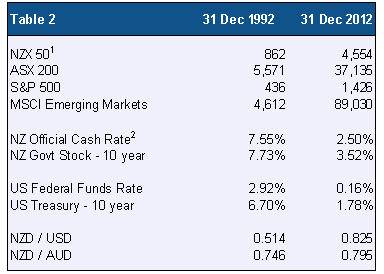
Note: The NZX 50, ASX 200 and MSCI indices include the return on dividends while the S&P 500 does not.
1 The NZX 50 only goes back to 2003 and so prior to then we used its predecessor, the NZSE 40.
2 The Official Cash Rate was introduced in 1999 and so we have shown the level of the overnight interbank cash rate at 30/12/92.
Individual sector returns
Table 3 shows the results for the individual asset classes over the 20 year period.
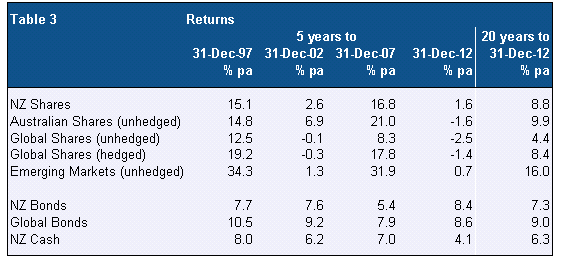
Commenting on the figures:
- Over the whole period the Australian share market has performed the best up 9.9% pa, a big number. Following this we have NZ shares at 8.8% pa and global bonds at 9.0% pa. NZ Government bonds achieve a respectable but lower result at 7.3% pa with cash not too far away at 6.3% pa. But the returns over the different 5 year periods tell a different story.
- For 2 of the 5 year periods we see strong share market returns. However the returns for the unhedged global shares are impacted on by a rising NZ$, worth 2.2% per annum over the period. This together with the forward points explains the 4.1% difference in the hedged and unhedged returns.
- Up until December 2007 NZ bonds and cash had similar overall returns but very different results for the last 5 years. Since October 2007 with the fall in cash rates made to help stimulate the economy and the rally in Government bonds the 2 sectors have very differing fortunes.
Below we show the results with a risk return chart illustrating the variability of each sectors’ results.
Chart 1
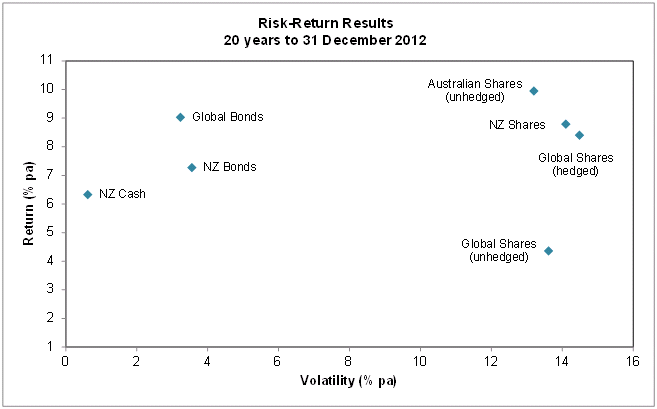
Commenting on the results:
- • The volatility is considerably lower for income (defensive) assets than for their growth counterparts.
- • The NZ and Australian shares achieve a high return providing some compensation for the significantly higher volatility experienced.
- • The risk premium measuring the difference between NZ shares and NZ bonds is worth just 1.5% per annum and will reflect the strong rally in recent years for NZ Government bonds.
- • Global bonds have outperformed NZ bonds, and interestingly with slightly less volatility.
Cumulative return
Chart 2 illustrates the cumulative returns over the period for the three portfolios.
Chart 2
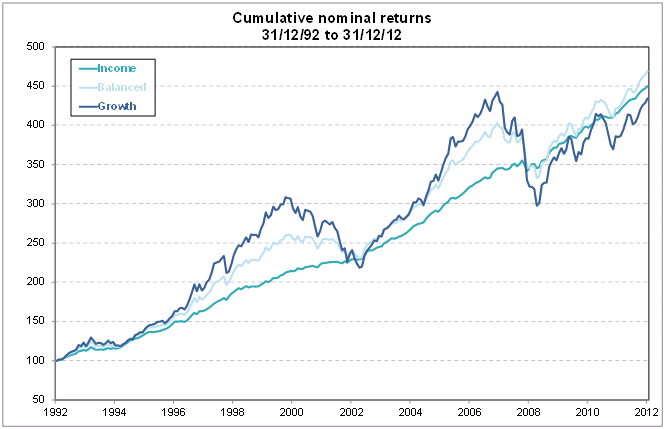
Commenting on the results:
- The three portfolios have very different volatilities with the Growth portfolio as expected experiencing the greatest amount of fluctuation and the Income portfolio the least. The Balanced portfolio has in contrast enjoyed a steady regular increase in returns with only an occasional negative result.
- There were intervals during the 20 year period when the growth portfolio was the top performing. As at 2007 the Growth portfolio was 190% of the Income portfolio. In contrast as at March 2009 the Growth portfolio was just 87% of the Income portfolio. The Balanced portfolio has in the main produced intermediate results, except currently where it is the top performing portfolio.
- Over the whole period, the difference in returns between the three portfolios is not significant. The Balanced portfolio has achieved the highest return at 7.9%, followed by the Income portfolio at 7.8% and the growth portfolio at 7.4%.
Separating out the returns from growth and income assets
The income and growth assets have very different characteristics. The income assets are there to provide steady annual returns with some certainty of preserving the capital invested. In contrast the growth assets are expected over time to produce the greater returns to compensate for the regular fluctuations of the returns. Put simply the investors in growth assets need the additional return if they are going to take the additional risks involved.
The following three charts illustrate the contribution made by the income and growth assets over the period to the total return of each portfolio.
Chart 3
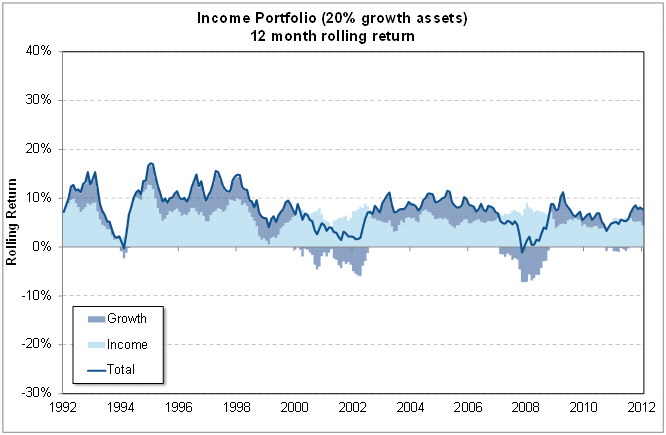
Chart 4
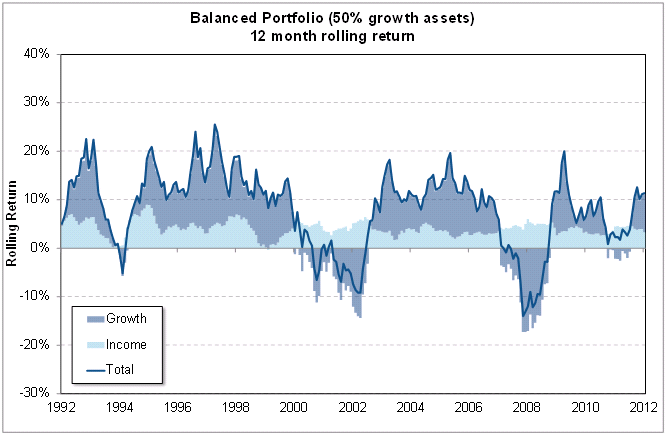
Chart 5
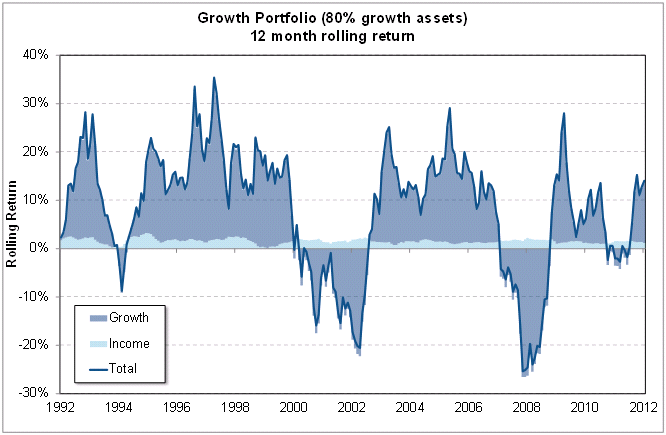
Commenting on the results:
Income portfolio
The light blue area is fairly steady over the period with the exception of 1994 and 2000 when interest rates rose and the fall in the capital value of the bonds reduced the total return from income assets. But, except for late 2008, the overall return on the portfolio has always been positive. The return on the shares component of the portfolio in contrast has been very variable but the limited exposure to this sector has limited the overall impact on the total return.
Growth portfolio
The overall return is dominated by the return on the growth assets with the income assets providing just a small cushion to reduce the losses in 1994 and 2000 to 2003 and the 2008/09 period.
Balanced portfolio
The results are naturally a combination of the lows and highs of the other two portfolios.
Changes in asset allocation over 15 years
Chart 6 illustrates how for a typical balanced fund the asset allocation has changed over the last 15 years. The fund illustrated for 1997 is the AMP “A” unit and for 2012 we have taken the AMP KiwiSaver balanced fund. The major changes for 2012 are increased exposure to global assets both bonds and shares. Back in 1997 the exposure to global bonds was minimal while for shares, global and NZ had almost identical allocations. Clearly the increase in global exposure makes the decision on currency exposure of prime importance.
Chart 6
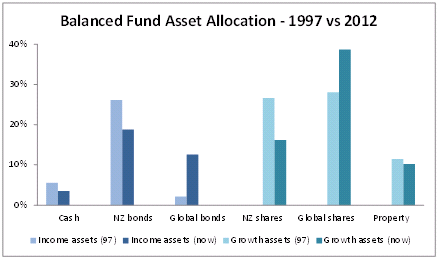
Conclusions
Looking at the results for the 3 portfolios we note:
- The strategic asset allocation dominates the overall return for a fund over the shorter periods. In time investors in the Growth portfolio would expect their return to exceed those of the other two portfolios.
- The last 20 years have been tough on investors with a high exposure to growth assets. They have not been rewarded for the additional volatility that they have experienced. However this needs to recognise that interest rates are at historic lows and the longer term outlook for bond investors is one of rising rates and reduced capital values – so based on this it looks like it could be a different picture going forward.
- While income assets have behaved broadly as one would expect ie providing a good income level with general capital preservation, this has been greatly assisted by the general downward movement in interest rates.
- The current tough market conditions with concerns over future growth levels mean it is a good time to review a fund’s strategic asset allocation. The issues are:
- What is the role of each asset held?
- here is the fund spending its risk budget? Are there some assets held which are now considered too risky?
- W hat is the best exposure level to share markets? Should the current level be increased?
- Are there any other sources of return which are significantly uncorrelated with the returns on listed securities? For example real assets such as commodities, forestry and infrastructure. If yes, would including them in the portfolio improve the risk return profile for the future.
- While the alternatives can look attractive what are the risks underlying them and what will the returns be?
Perhaps the only clear conclusion to reach from the analysis is that investors will need to lower the investment returns they expect in the future and manage to this new normal accordingly. A year ago we were needing to start thinking more in terms of the lower returns going forward, come the end of 2012 accepting the lower returns now seems to be a given.
| « Harbour Monthly Commentary: Stronger global growth signals | Hamish Douglass Unplugged - Latest Video from Adviser Briefing - August 2012 » |
Special Offers
Commenting is closed
| Printable version | Email to a friend |









